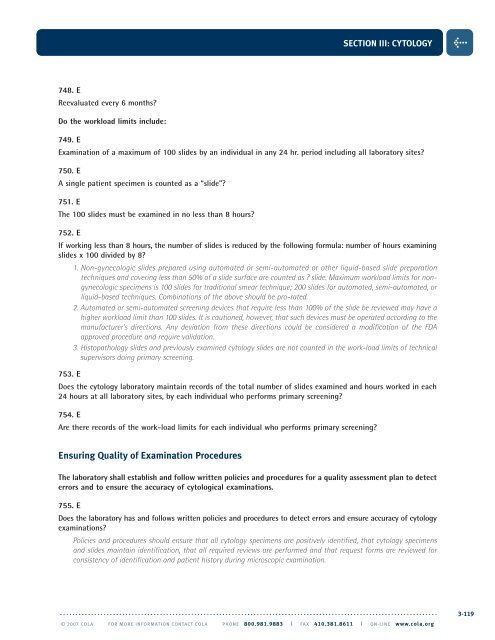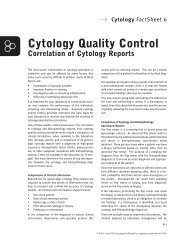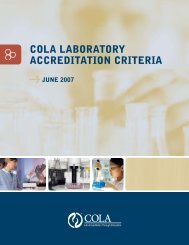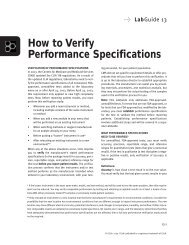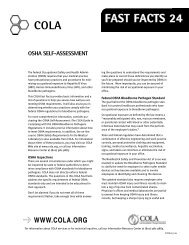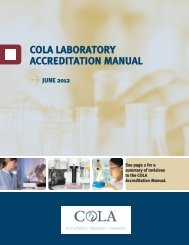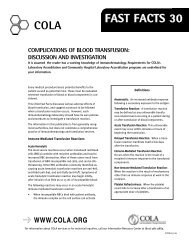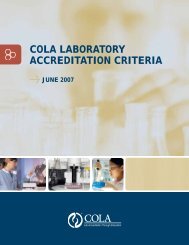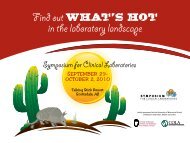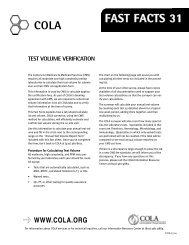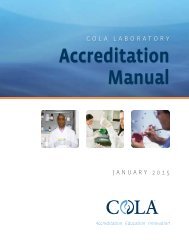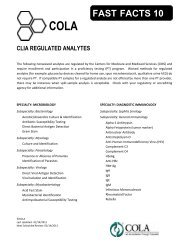Download - COLA
Download - COLA
Download - COLA
- No tags were found...
You also want an ePaper? Increase the reach of your titles
YUMPU automatically turns print PDFs into web optimized ePapers that Google loves.
SECTION III: CYTOLOGY>748. EReevaluated every 6 months?Do the workload limits include:749. EExamination of a maximum of 100 slides by an individual in any 24 hr. period including all laboratory sites?750. EA single patient specimen is counted as a “slide”?751. EThe 100 slides must be examined in no less than 8 hours?752. EIf working less than 8 hours, the number of slides is reduced by the following formula: number of hours examiningslides x 100 divided by 8?1. Non-gynecologic slides prepared using automated or semi-automated or other liquid-based slide preparationtechniques and covering less than 50% of a slide surface are counted as ? slide. Maximum workload limits for nongynecologicspecimens is 100 slides for traditional smear technique; 200 slides for automated, semi-automated, orliquid-based techniques. Combinations of the above should be pro-rated.2. Automated or semi-automated screening devices that require less than 100% of the slide be reviewed may have ahigher workload limit than 100 slides. It is cautioned, however, that such devices must be operated according to themanufacturer’s directions. Any deviation from these directions could be considered a modification of the FDAapproved procedure and require validation.3. Histopathology slides and previously examined cytology slides are not counted in the work-load limits of technicalsupervisors doing primary screening.753. EDoes the cytology laboratory maintain records of the total number of slides examined and hours worked in each24 hours at all laboratory sites, by each individual who performs primary screening?754. EAre there records of the work-load limits for each individual who performs primary screening?Ensuring Quality of Examination ProceduresThe laboratory shall establish and follow written policies and procedures for a quality assessment plan to detecterrors and to ensure the accuracy of cytological examinations.755. EDoes the laboratory has and follows written policies and procedures to detect errors and ensure accuracy of cytologyexaminations?Policies and procedures should ensure that all cytology specimens are positively identified, that cytology specimensand slides maintain identification, that all required reviews are performed and that request forms are reviewed forconsistency of identification and patient history during microscopic examination.. . . . . . . . . . . . . . . . . . . . . . . . . . . . . . . . . . . . . . . . . . . . . . . . . . . . . . . . . . . . . . . . . . . . . . . . . . . . . . . . . . . . . . . . . . . . . . . . . . . . . . . . . . . . . . . . . . . . . . . . .© 2007 <strong>COLA</strong> FOR MORE INFORMATION CONTACT <strong>COLA</strong> PHONE 800.981.9883 | FAX 410.381.8611 | ON-LINE www.cola.org3-119


